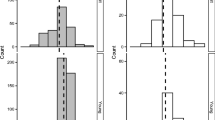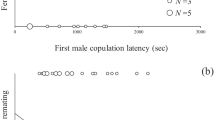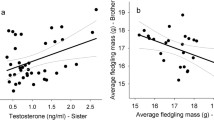Abstract
Several studies suggest that females may offset the costs of genetic incompatibility by exercising pre-copulatory or post-copulatory mate choice to bias paternity toward more compatible males. One source of genetic incompatibility is the degree of relatedness among mates; unrelated males are expected to be genetically more compatible with a female than her relatives. To address this idea, we investigated the potential for inbreeding depression and paternity biasing mechanisms (pre- and post-copulatory) of inbreeding avoidance in the guppy, Poecilia reticulata. Inbreeding resulted in a reduction in offspring number and quality. Females mated to siblings gave birth to significantly fewer offspring compared to females mated to non-siblings and inbred male offspring took longer to reach sexual maturity. There was no evidence of inbreeding avoidance in pre-copulatory behaviors of females or males. Sexual responsiveness of females to courting males and the number of sexual behaviors males directed at females did not decrease as a function of the relatedness of the two individuals. We also tested whether female guppies can use post-copulatory mechanisms to bias sperm usage toward unrelated males by comparing the number of offspring produced by females mated to two of their siblings (SS), two males unrelated to the female (NN), or to one unrelated male and a sibling male (NS). We found that NS females produced a number of offspring not significantly different than what would be expected if fertilization success were halfway between completely outbreeding (NN) and completely inbreeding (SS) females. This suggests that there is no significant improvement in the number of offspring produced by females mating to both related and unrelated males, relative to that which would be expected if sperm from both males were used equally. Our results suggest that female guppies do not discriminate against closely related males or their sperm.



Similar content being viewed by others
References
Andersson M (1982) Sexual selection, natural selection, and quality advertisement. Biol J Linn Soc 17:375–393
Andersson M (1986) Evolution of condition-dependent sex ornaments and mating preferences: Sexual selection based on viability differences. Evolution 40:804–816
Bozynski CC, Liley NR (2003) The effect of female presence on spermiation, and of male sexual activity on ‘ready’ sperm in the male guppy. Anim Behav 65:53–58
Breden F, Novinger D, Schubert A (1995) The effect of experience on mate choice in the Trinidadian guppy, Poecilia reticulata. Env Biol Fish 42:323–328
Bretman A, Wedell N, Tregenza T (2004) Molecular evidence of post-copulatory inbreeding avoidance in the field cricket Gryllus bimaculatus. Proc R Soc Lond B 271:159–164
Cheng YY (2004) Sexual selection and the evolution of genetalia in the guppy (Poecilia reticulata). MSc Dissertation, University of Toronto
Cook PA, Harvey IF, Parker GA (1997) Predicting variation in sperm precedence. Phil Trans R Soc Lond B 352:771–780
Denk AG, Holzmann A, Peters A, Vermeirssen ELM, Kempenaers B (2005) Paternity in mallards: effects of sperm quality and female sperm selection for inbreeding avoidance. Behav Ecol 16:825–833
Dosen LD, Montgomerie R (2004) Female size influences mate preferences of male guppies. Ethology 110:245–255
Endler JA, Houde AE (1995) Geographic variation in female preferences for male traits in Poecilia reticulata. Evolution 49:456–468
Evans JP, Magurran AE (2000) Multiple benefits of multiple mating in guppies. Proc Natl Acad Sci USA 97:10074–10076
Evans JP, Magurran AE (2001) Patterns of sperm precedence and predictors of paternity in the Trinidadian guppy. Proc R Soc Lond B 268:719–724
Evans JP, Zane L, Francescato S, Pilastro A (2003a) Directional postcopulatory sexual selection revealed by artificial insemination. Nature 421:360–363
Evans JP, Pilastro A, Ramnarine IW (2003b) Sperm transfer through forced matings and its evolutionary implications in natural guppy (Poecilia reticulata) populations. Biol J Linn Soc 78:605–612
Farr JA (1977) Male rarity or novelty, female choice behavior and sexual selection in the guppy Poecilia reticulata Peters (Pisces: Poeciliidae). Evolution 31:162–168
Farr JA, Peters K (1984) The inheritance of quantitative fitness traits in guppies, Poecilia reticulata (Pisces, Poecillidae). 2. Tests for inbreeding effects. Heredity 52:296–296
Field KL, Waite TA (2004) Absence of female conspecifics induces homosexual behaviour in male guppies. Anim Behav 68:1381–1389
Gage MJG, Surridge AK, Tomkins JL, Green E, Wiskin L, Bell DJ, Hewitt GM (2006) Reduced heterozygosity depresses sperm quality in wild rabbits, Oryctolagus cuniculus. Curr Biol 16:612–617
Garcia-Gonzalez F, Simmons LW (2007) Paternal indirect genetic effects on offspring viability and the benefits of polyandry. Curr Biol 17:32–36
Griffiths SW, Magurran AE (1997) Schooling preferences for familiar fish vary with group size in a wild guppy population. Proc R Soc Lond B 264:547–551
Griffiths SW, Magurran AE (1999) Schooling decisions in guppies (Poecilia reticulata) are based on familiarity rather than kin recognition by phenotype matching. Behav Ecol Sociobiol 45:437–443
Hain TJA, Neff BD (2007) Multiple paternity and kin recognition in a guppy population. Mol Ecol 16:3938–3946
Houde AE (1988) The effects of female choice and male-male competition on the mating success of male guppies. Anim Behav 36:888–896
Houde AE (1997) Sex, colour, and mate choice in guppies. Princeton University Press, New Jersey, 224 pp
Hughes KA, Du L, Rodd FH, Reznick DN (1999) Familiarity leads to female mate preference for novel males in the guppy, Poecilia reticulata. Anim Behav 58:907–916
Huitema BE (1980) The analysis of covariance and alternatives. Wiley, New York, 460 pp
Iwasa Y, Pomiankowski A (1991) The evolution of costly mate preferences. II. The handicap principle. Evolution 45:1431–1442
Jennions MD, Hunt J, Graham R, Brooks R (2004) No evidence for inbreeding avoidance through postcopulatory mechanisms in the black field cricket, Teleogryllus commodus. Evolution 58:2472–2477
Keane B, Creel SR, Waser PM (1996) No evidence of inbreeding avoidance or inbreeding depression in a social carnivore. Behav Ecol 7:480–489
Keller LF, Arcese P (1998) No evidence for inbreeding avoidance in a natural population of song sparrows (Melospiza melodia). Am Nat 152:380–392
Keller LF, Waller DM (2002) Inbreeding effects in wild populations. Trends Ecol Evol 17:230–241
Kelley JL, Graves JA, Magurran AE (1999) Familiarity breeds contempt in guppies. Nature 401:661–662
Kelly CD, Godin J-G, Wright JM (1999) Geographic variation in multiple paternity within natural populations of the guppy (Poecilia reticulata). Proc R Soc Lond B 266:2403–2408
Kokko H, Ranta E, Ruxton G, Lundberg P (2002) Sexually transmitted disease and the evolution of mating systems. Evolution 56:1091–1100
Madsen T, Shine R, Loman J, Hakansson T (1992) Why do females copulate so frequently. Nature 355:440–441
Manson JH, Perry SE (1993) Inbreeding avoidance in rhesus macaques—whose choice. Am J Phys Anthropol 90:335–344
Margulis SW, Walsh A (2002) The effects of inbreeding on testicular sperm concentration in Peromyscus polionotus. Reprod Fertil Dev 14:63–67
Mariette M, Kelley JL, Brooks R, Evans JP (2006) The effects of inbreeding on male courtship behaviour and coloration in guppies. Ethology 112:807–814
Nakadate M, Shikano T, Taniguchi N (2003) Inbreeding depression and heterosis in various quantitative traits of the guppy, Poecilia reticulata. Aquaculture 220:219–226
Neff BD, Pitcher TE (2005) Genetic quality and sexual selection: an integrated framework for good genes and compatible genes. Mol Ecol 14:19–38
Neff BD, Pitcher TE, Ramnarine I (2007) Inter-population variation in multiple paternity and reproductive skew in the guppy. Mol Ecol, in review
Olsson M, Shine R, Madsen T, Gullberg A, Tegelström H (1996) Sperm selection by females. Nature 383:585
Parker GA, Simmons LW, Kirk H (1990) Analysing sperm competition data: simple models for predicting mechanisms. Behav Ecol Sociobiol 27:55–65
Pilastro A, Bisazza A (1999) Insemination efficiency of two alternative male mating tactics in the guppy (Poecilia reticulata). Proc R Soc Lond B 266:1887–1891
Pitcher TE, Evans JP (2001) Male phenotype and sperm number in the guppy (Poecilia reticulata). Can J Zool 79:1891–1896
Pitcher TE, Neff BD, Rodd H, Rowe L (2003) Multiple mating and sequential mate choice in guppies: females trade up. Proc R Soc Lond B 270:1623–1629
Pitcher TE, Rodd H, Rowe L (2007) Sexual coloration and sperm traits in guppies. J Fish Biol 70:165–177
Pizzari T, Lovlie H, Cornwallis CK (2004) Sex-specific, counteracting responses to inbreeding in a bird. Proc R Soc Lond B 271:2115–2121
Pomiankowski A (1987) The costs of choice in sexual selection. J Theor Biol 128:195–218
Pomiankowski A (1988) The evolution of female mate preference for male genetic quality. Oxf Surv Evol Biol 5:136–184
Reynolds JD, Gross MR (1992) Female mate preference enhances offspring growth and reproduction in a fish, Poecilia reticulata. Proc R Soc Lond B 250:57–62
Reznick DN, Butler MJ, Rodd FH, Ross P (1996) Life-history evolution in guppies (Poecilia reticulata) VI. Differential mortality as a mechanism for natural selection. Evolution 50:1651–1660
Roldan ERS, Cassinello J, Abaigar T, Gomendio M (1998) Inbreeding, fluctuating asymmetry, and ejaculate quality in an endangered ungulate. Proc R Soc Lond B 265:243–248
Rosenqvist G, Houde A (1997) Prior exposure to male phenotypes influences mate choice in the guppy, Poecilia reticulata. Behav Ecol 8:194–198
Rowe L (1994) The costs of mating and mate choice in water striders. Anim Behav 48:1049–1056
SAS Institute, Inc. (1989) SAS/STAT user’s guide, v.6. Cary. SAS Institute, Inc., North Carolina
Sheridan L, Pomiankowski A (1997) Fluctuating asymmetry, spot asymmetry and inbreeding depression in the sexual coloration of male guppy fish. Heredity 79:515–523
Shikano T, Taniguchi N (2002) Heterosis for neonatal survival in the guppy. J Fish Biol 60:715–725
Simmons LW (1991) Female choice and the relatedness of mates in the field cricket, Gryllus bimaculatus. Anim Behav 41:493–501
Simmons LW (2001) The evolution of polyandry: an examination of the genetic incompatibility and good-sperm hypotheses. J Evol Biol 14:585–594
Simmons LW (2005) The evolution of polyandry: Sperm competition, sperm selection and offspring viability. Annu Rev Ecol Evol Syst 36:125–146
Stockley P (1997) No evidence of sperm selection by female common shrews. Proc R Soc Lond B 264:1497-1500
Stow AJ, Sunnucks P (2004) Inbreeding avoidance in Cunningham’s skinks (Egernia cunninghami) in natural and fragmented habitat. Mol Ecol 13:443–447
Tregenza T, Wedell N (2000) Genetic compatibility, mate choice and patterns of parentage: invited review. Mol Ecol 9:1013–1027
Tregenza T, Wedell N (2002) Polyandrous females avoid costs of inbreeding. Nature 415:71–73
Trivers RL (1972) Parental investment and sexual selection. In: Campbell (ed) Sexual selection and the descent of man. Aladine, Chicago
van Oosterhout C, Trigg RE, Carvalho GR, Magurran AE, Hauser L, Shaw PW (2003) Inbreeding depression and genetic load of sexually selected traits: how the guppy lost its spots. J Evol Biol 16:273–281
Viken A, Fleming IA, Rosenqvist G (2006) Premating avoidance of inbreeding absent in female guppies (Poecilia reticulata). Ethology 112:716–723
Waser PM, Austad SN, Keane B (1986) When should animals tolerate inbreeding? Am Nat 128:529–537
Wildt DE, Bush M, Goodrowe KL, Packer C, Pusey AE, Brown JL, Joslin P, O’Brien SJ (1987) Reproductive and genetic consequences of founding isolated lion populations. Nature 329:328–331
Zahavi A (1975) Mate selection—selection for a handicap. J Theor Biol 53:205–214
Zar JH (1999) Biostatistical analysis. Prentice-Hall, New Jersey
Zeh JA, Zeh DW (1996) The evolution of polyandry I: Intragenomic conflict and genetic incompatibility. Proc R Soc Lond B 263:1711–1717
Zeh JA, Zeh DW (1997) The evolution of polyandry II: Post-copulatory defenses against genetic incompatibility. Proc R Soc Lond B 264:69–75
Zeh JA, Zeh DW (2003) Toward a new sexual selection paradigm: Polyandry, conflict, and incompatibility. Ethology 109:929–950
Zeh JA, Zeh DW (2006) Outbred embryos rescue inbred half-siblings in mixed-paternity broods of live-bearing females. Nature 439:201–203
Acknowledgments
We are grateful to Maydianne Andrade, Darryl Gwynne, Andrew Hendry, Anne Houde, and David Punzalan for helpful discussion and advice, and Kim Hughes for statistical advice. We also thank Tracy Michalak, Gina Shillolo, Tammy Chung and all the undergraduate assistants for help with animal husbandry. This work was supported by the Natural Science and Engineering Council of Canada (scholarships to TEP and research grants to FHR and LR), Department of Zoology at the University of Toronto (to TEP and FHR), Government of Ontario (PREA grants to FHR. and LR), and the US government (NSF grants (DEB-0128455 and DEB-0128820)). The guppies used in this study were cared for in accordance with the principles and guidelines of the Canadian Council on Animal Care. This work is dedicated to the memory of the late Theresa Lai.
Author information
Authors and Affiliations
Corresponding author
Rights and permissions
About this article
Cite this article
Pitcher, T.E., Rodd, F.H. & Rowe, L. Female choice and the relatedness of mates in the guppy (Poecilia reticulata). Genetica 134, 137–146 (2008). https://doi.org/10.1007/s10709-008-9246-x
Received:
Accepted:
Published:
Issue Date:
DOI: https://doi.org/10.1007/s10709-008-9246-x




